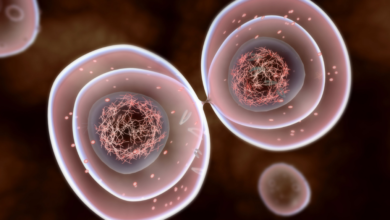
What is Smoldering Myeloma?
Smoldering myeloma is a precancerous condition where abnormal plasma cells accumulate in the bone marrow but without causing significant symptoms or organ damage. It’s considered a precursor to multiple myeloma.
Types of Smoldering Myeloma
While there aren’t distinct subtypes of smoldering myeloma, it can be classified based on the specific genetic abnormalities present in the cancer cells. However, these classifications are primarily used for research purposes and don’t significantly impact treatment decisions.
Symptoms of Smoldering Myeloma
People with smoldering myeloma often don’t experience any noticeable symptoms. However, some individuals may have mild symptoms like fatigue or bone pain.
Causes of Smoldering Myeloma
The exact cause of smoldering myeloma is unknown. However, certain factors may increase the risk, such as:
• Age: Smoldering myeloma is more common in older adults.
• Exposure to radiation or certain chemicals: Exposure to these substances can increase the risk of certain cancers.
• Genetic factors: Certain genetic mutations may increase the risk.
Who Can Suffer from Smoldering Myeloma?
Smoldering myeloma primarily affects older adults.
Diagnostic Tests for Smoldering Myeloma
To diagnose smoldering myeloma, a doctor may use a combination of tests, including:
• Blood tests: To check for abnormalities in the blood cells and levels of abnormal proteins.
• Urine tests: To check for abnormal proteins in the urine, such as Bence-Jones proteins.
• Bone marrow aspiration and biopsy: To examine bone marrow cells.
• Imaging tests: X-rays, CT scans, MRIs, and PET scans may be used to assess bone health.
Stages of Smoldering Myeloma
Smoldering myeloma is not typically staged. Instead, it’s monitored closely to determine when it progresses to active myeloma.
Treatment of Smoldering Myeloma
Since smoldering myeloma is a precancerous condition, active treatment is typically not necessary unless the disease progresses to active myeloma. However, regular monitoring is essential to detect any signs of progression.
Diet and Smoldering Myeloma Prevention
While a healthy diet cannot directly prevent smoldering myeloma, it can support overall health and strengthen the immune system. Here are some general dietary recommendations:
• A balanced diet: A diet rich in fruits, vegetables, and whole grains can help.
• Limit processed foods and sugary drinks: These can contribute to weight gain and other health problems.
• Maintain a healthy weight: Obesity is linked to an increased risk of certain cancers.
Overall Survival Rate of Smoldering Myeloma
The overall survival rate for individuals with smoldering myeloma can vary widely. While some individuals may live for many years without the disease progressing, others may eventually develop active myeloma. Regular monitoring is crucial to detect any signs of progression and to initiate appropriate treatment.
Doctor to Consult
A hematologist-oncologist is the best doctor to consult for smoldering myeloma.
Diseases Associated with Smoldering Myeloma
Smoldering myeloma is a precancerous condition, not a cancer itself. However, it is a precursor to multiple myeloma, a type of blood cancer.
How to Prevent Smoldering Myeloma
While there’s no guaranteed way to prevent smoldering myeloma, maintaining a healthy lifestyle can reduce the risk of certain factors that may contribute to the development of myeloma:
• Limit exposure to radiation and certain chemicals: Exposure to these substances can increase the risk of certain types of cancer.
• Maintain a healthy weight: Obesity is linked to an increased risk of certain cancers.
• Regular check-ups: Regular check-ups can help detect any abnormalities early on.
• Healthy lifestyle: A healthy lifestyle, including a balanced diet and regular exercise, can help boost the immune system.





